The Guru is the Goya 4 battens control wave sail, for side/side off wind conditions. In these months, we have had the opportunity to test the model 2020/21, in the 4.7 size, and in this article we show you the results.
Windsurf, test: Goya Guru X Pro 2020/2021 4.7
Tech Specs
Surface: 4,7 m2
Boom: 158-161 cm
Luff: 407 cm
Mast: 400 RDM
Fixed Top, 4 battens
Checked weight: 3.6 kg
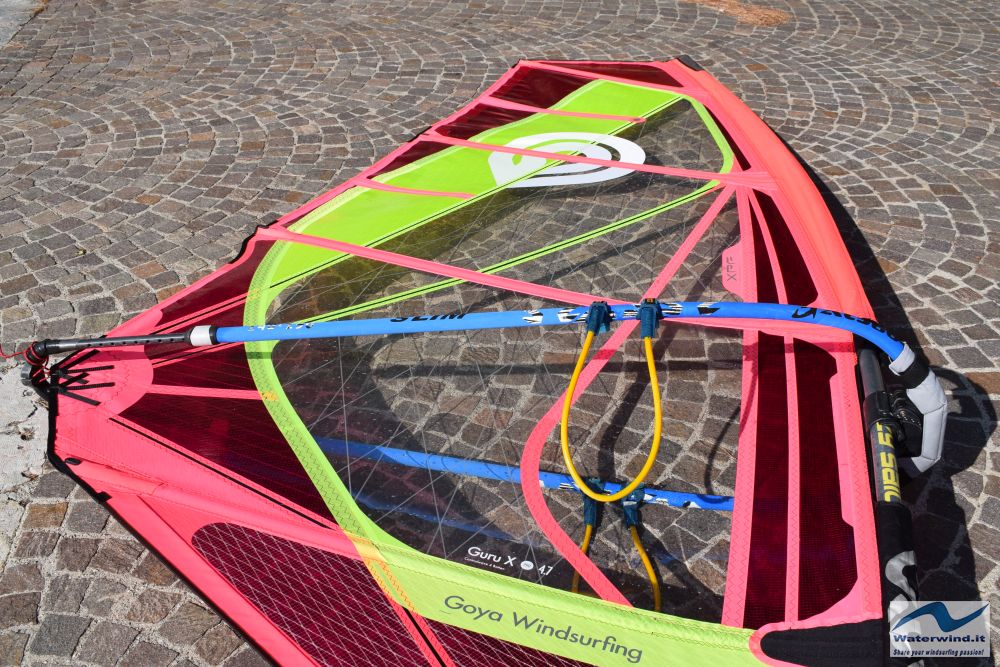
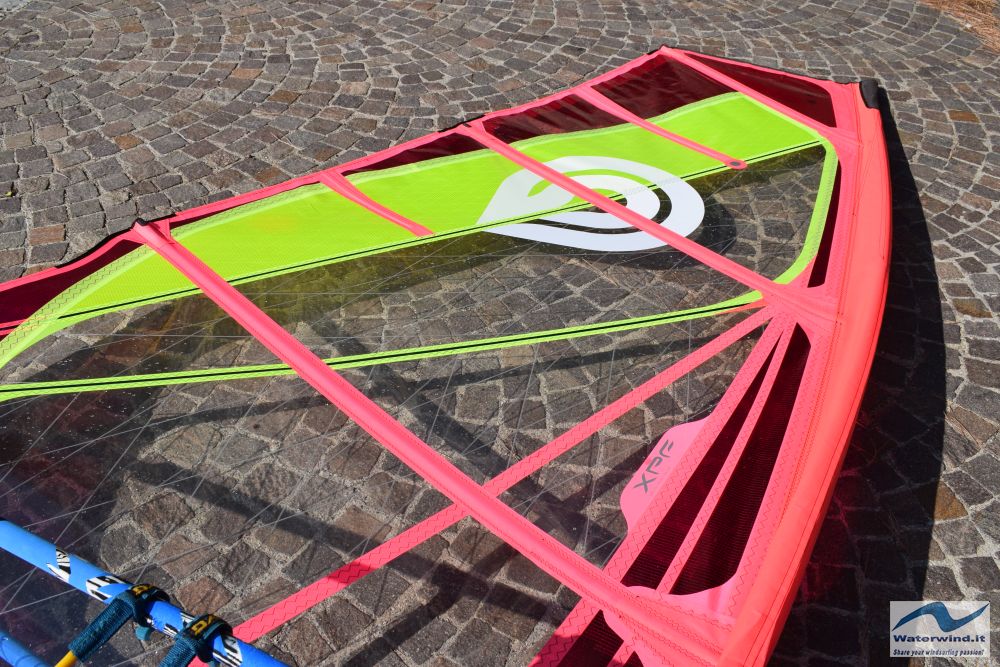
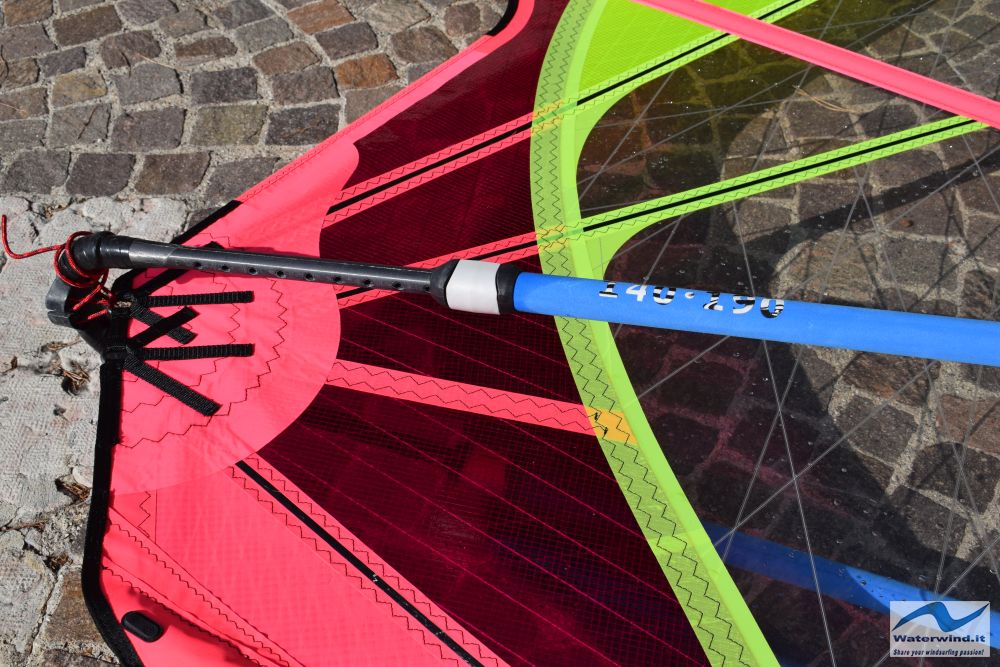
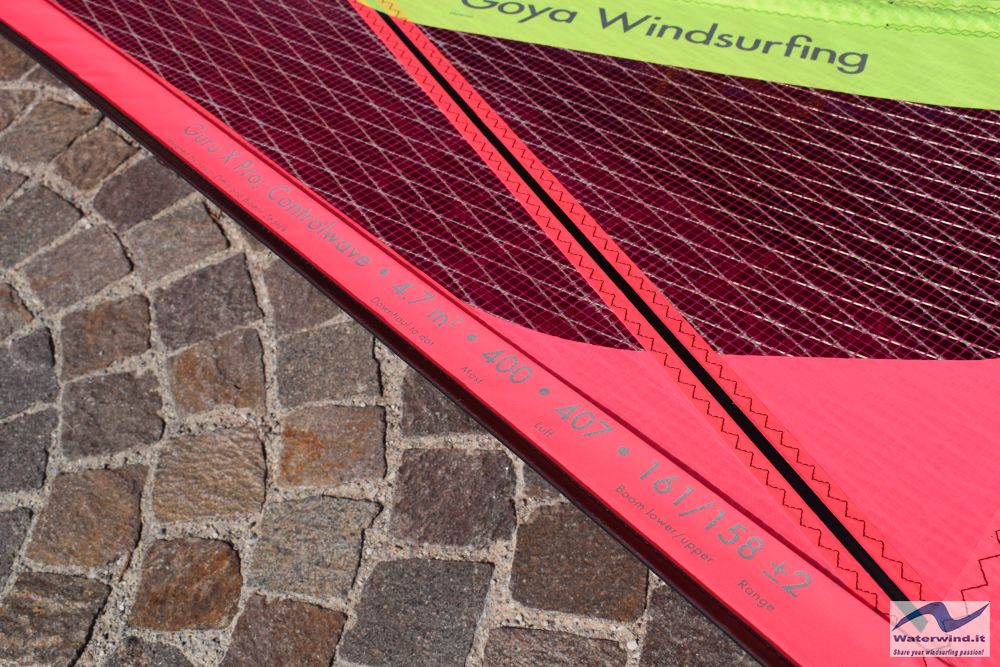
The brand claims:
"Wave performance and also high wind comfort, confidence and control in any water condition. The vinyl window makes the Guru X Pro unique. It creates a very smooth and comfortable power delivery, as well as the most durable sail in our lineup. Vinyl is practically indestructible and will stay crystal clear for the life of the sail. The new Guru X Pro is the result of 25 years of design evolution and the process and progress continues.
Francisco Goya claims it as his personal favorite, and as of late, Levi Siver has been spending time on the Guru X Pro in the pure wave conditions of Ho’okipa and loving it. Makes sense, because that’s where the design was born and established many years ago.
Continuing its development around the world, high winds of The Gorge, and spots like Pozo have helped to tune up the smaller sizes to work as magnificent as the rest of the line. The goal has always been for the 3.2 to feel like the 4.7 and through lots of prototypes and testing in those extreme conditions were we finally able to achieve it.
Guru X Pro offers a huge rigging range. With it’s soft power delivery and smooth progressive twist, you can rig this sail very full and still fill comfortably in control. Rigging the sail flatter on the outhaul is possible for a more neutral handling feel in higher wind and maneuver-oriented conditions".
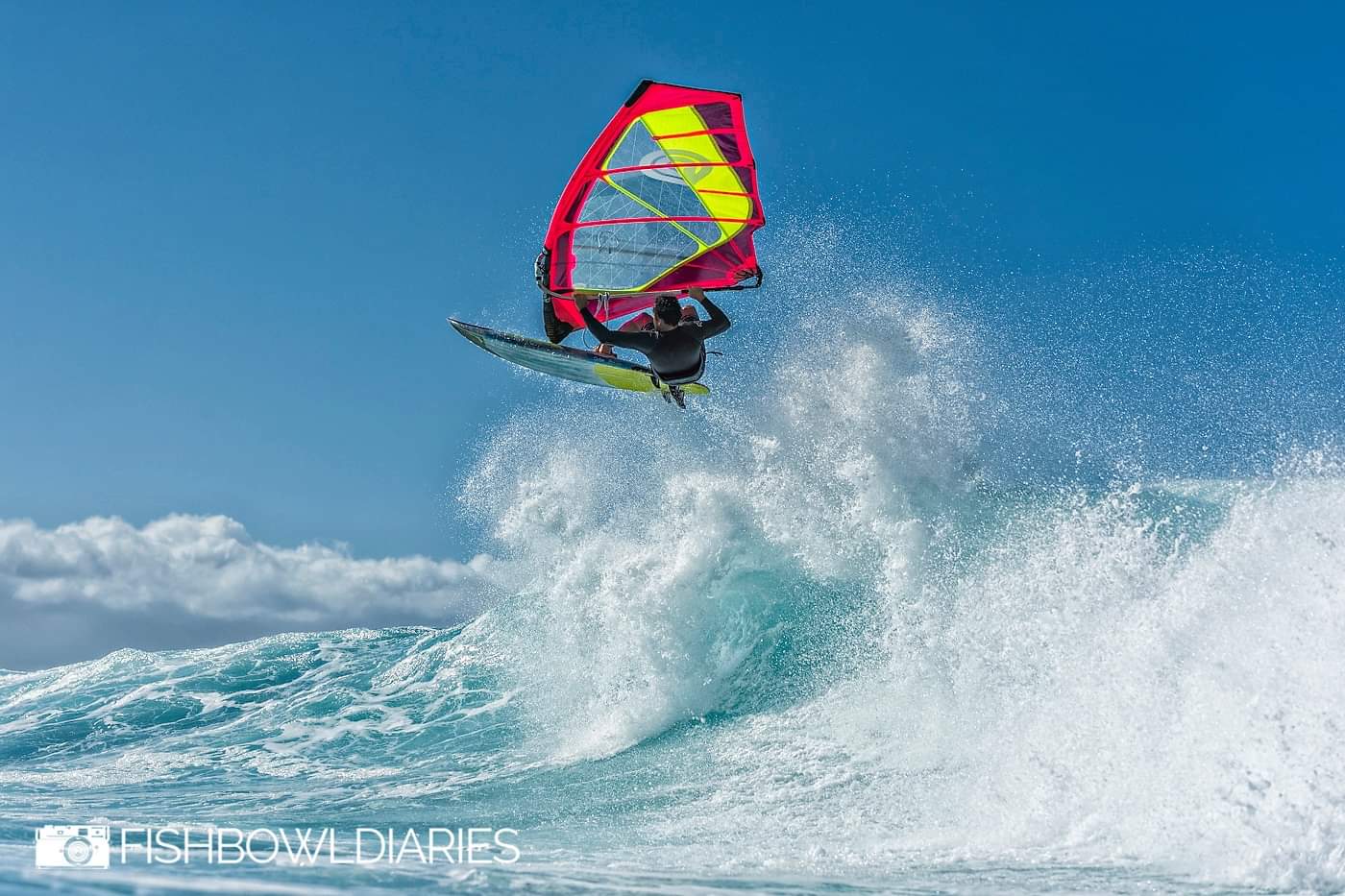
And as for the construction, he adds the following indications.
Vinyl Window. Vilyl delivers a flexible feel to the sail as a whole, and the window, with a little maintenance, will stay clear for the life of the sail.
X-Ply Window Panels. X-Ply offers the same weight and feel of a clear window construction. The difference is increased durability through improved tear resistance. X-Ply film reinforced with yarns is incredibly tear resistant, the perfect body panel material for people looking for maximum durability. Featured on Banzai X, Guru, Scion.
Scrim Luff Panels. The colored Scrim material used in the main panels offers super strong durability, super light weight and a supple and alive feel throughout the sail.
Hybrid dacron/scrim luff panels, Carbon Stretch Control, Poly Clew Titanium Clew Rings, Rip Stop Sleeve and a Molded Tack Fairing round off the peak quality package. Sleeve cut treatments as well as tack and foot reinforcements are now folded to increase durability and prevent edge fraying. A wider scalloped upper leech reinforcement prevents breakdown of the leech from fluttering in strong wind conditions such as Omaezaki, the Gorge and Pozo.
Our impressions regarding structure and materials
The sail structure appears tough. The X-Ply panels, reinforced with yarns, guarantee, in case of film tearing, that the cut does not spread outside the yarns perimeter. However, do not imagine the flexibility and resistance that an Ezzy can offer you (it's our inevitable comparison term, given that we have been using that sail brand for a long time), which, from this point of view, seem to us unmatched so far (the softer Ezzy X-Ply, with its thick weave, has, however, other reflections on the performance of Ezzy sail, which are notoriously, also for this reason, very neutral).
The mast sleeve has a very regular curve. Therefore, as suggested by the manufacturer in his tuning guide, when you insert the mast inside, do not push it all from the sleeve base, but, gently push it in the sleeve, while holding the the mast sleeve with one hand positioned on the top and the other at the bottom of the boom cut (thus folding the sail in correspondence of the boom cut). Friction between mast and sleeve is reduced, in this way.
The sleeve base requires a little care and your attention, when rigging, to avoid or reduce friction with the mast and the extension, if you want the sail to last for long. The net inside the sleeve base for storing the downhaul rope excess has a top (and not a side) entrance, which can be slightly uncomfortable.
The sail has a quite a significant surface also in the upper part, according to a typical tendency of a lot of modern wave sails, which borrow this shape from freestyle sails; anyway, as explained later, the way of rigging the sail - dowhauling to the dot to have enough loosen leech - and the correct use of the two clew rings, allow you to better adjust the power of the sail in the upper part.
The sail bag (even if it is not a fundamental aspect in these products) could be improved: the lateral metal hinge at one of the two ends is a bit uncomfortable when the sail is taken out and put back in the bag; the part of mesh fabric (to disperse the humidity) positioned in the longitudinal direction does not seem the best solution.
Ezzy, more effectively, adopts a lace that slides inside a plastic retainer - salt-proof - to close the sail bag to one end, and the mesh fabric is positioned at the opposite end, so that the sail can drip at best, when placed vertically.
Rigging and tuning the sail
As a premise, we point out that we have rigged the sail both with an Ezzy Hookipa 400 rdm mast (extension set to 8 cm), and with a combination of Top 400 RDM Ezzy Hookipa mast, and 370 bottom (in this case, with extension set to 22 cm, better 24, if you want to let yourself a certain tuning margin). The sail in both cases seemed to be properly rigged, and in the water offered optimal performance. The Ezzy masts (constant curves tending to the flex top), are among those most compatible with Goya sails. Moreover, they were produced by Nolimitz, so far, like the Goya masts.
Otherwise, the sail is obviously rigged with a Goya RDM 400 mast. In the Faqs available on the manufacturer's website, it is also suggested the chance to rig the sail with a Goya 370 rdm mast top, and a 400 bottom; with this combination the sail would be even softer. We tried a similar combination with the Ezzy masts (always, setting the extension to 22), but it seemed to us that the sail had a too much loosen leech, like this, in order to have an adequate mast curve in the lower part - i.e. battens that do not point against the sleeve (probably, that is due to slight curvature differences between the two brands mast tops and the bottom). This solution did not seem impossible to us, but it seemed to limit the sail tuning margins, which are one of the strengths, in our opinion, of this product.
The sail, as clearly explained (in the tuning guide, and on the sail itself), must be rigging downhauling to the dot positioned in the upper part of the sail. In the tuning guides of the manufacturer, it is always advisable to get a sail loosen leech like this, as it will work best in most conditions. Only in light winds, you can sheet the downhaul slightly less. The sail complies with the suggested measures regarding the extension size trimming.
As for the clew, the Guru has two rings (Poly Clew), like the Goya Banzai; the upper one to be used to fix the boom end in lighter wind conditions (or heavier rider, or more interested to power), the lower one for stronger wind (or lighter rider, or more maneuvers oriented), inside the sail range of use. Each ring tighten two distinct carbon strips (Carbon strech control - see photo), which make the upper profile of the sail tense. This system on the Guru is particularly effective. You can also use the two clews at same time, achieving a mix of sail performance between the two above described. Regarding the boom length size (the range, 158-161 cm, is rather restricted), the manufacturer's indications are substantially respected. With 161 cm, using the upper clew ring, you will also have a sail that is too tight at the lower side. 159 cm seemed to us a more balanced measure. With the lower clew ring, you can go down a couple of centimeters. Unlike other sails, the Guru becomes more or less powerful, acting mainly on the choice of the clew ring rather than on the outhaul tension. However, with use, experience will lead you to get the best out of this very versatile sail.
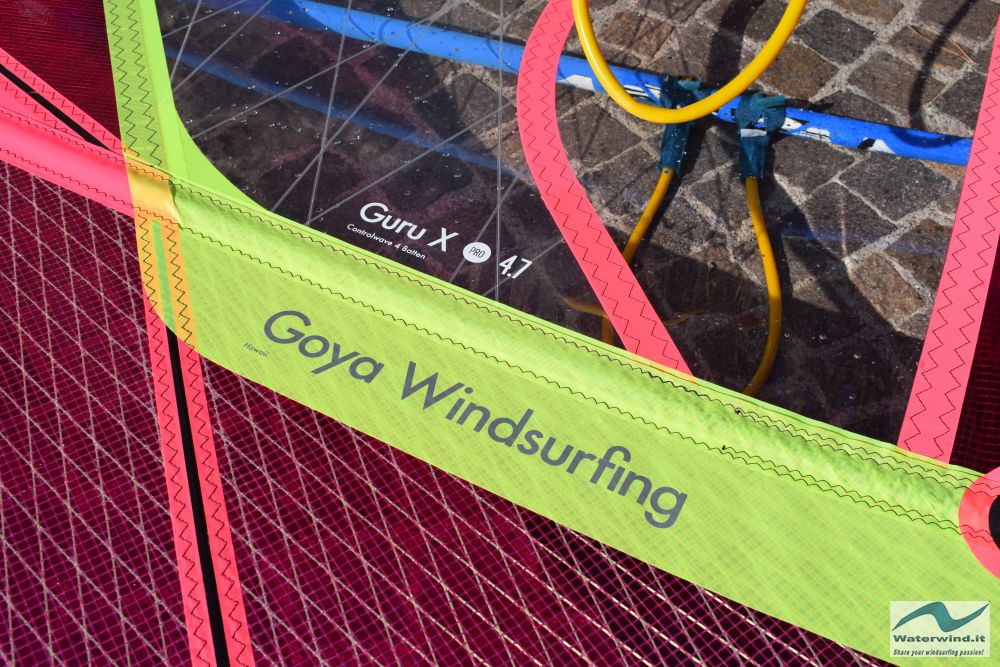
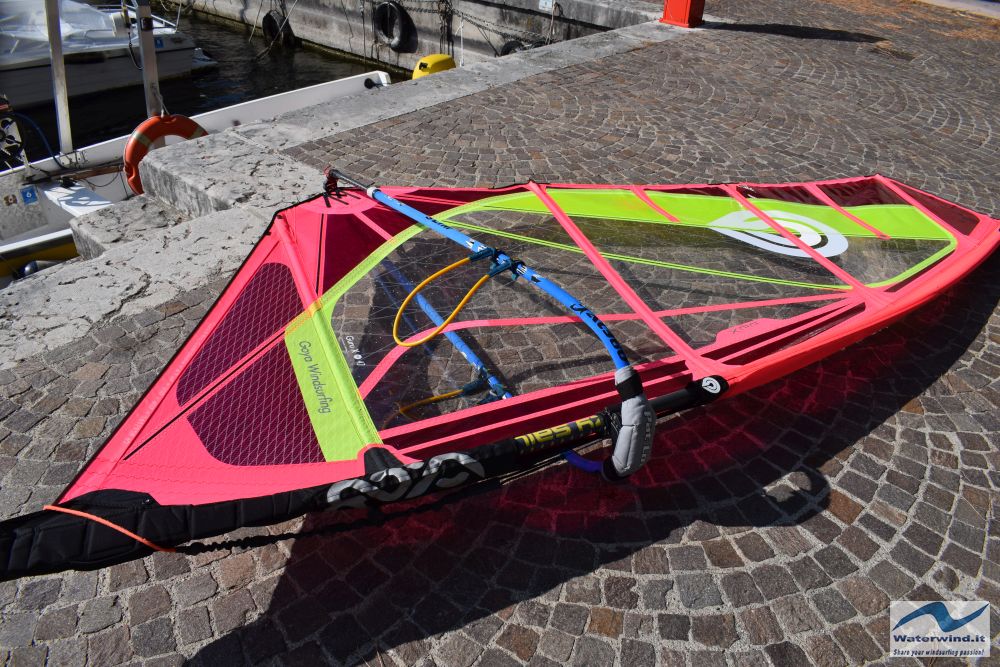
Results of the test in the water
The sail was first tested at the Prà de la Fam, Lake Garda, with 22-24 knots wind, a speed at which for me (70 kg) the sail was the right size. Without wasting too many words, I fell in love with the Guru instantly, which thrilled me from all points of view. When sailing on a straight line, it is impressive how it is not tiring: light and neutral; the boom is held in hands with very little effort. In maneuver, both in tack and in jibe, it is even better: it easily cuts through the wind, when tacking, and is light but powerful, when jibing. It dissipates the wind excess well on the gusts, without putting yourself into any difficulty. Only at the glide entrance, on the occasion of some less powerful gust, it responds to pumping in a slightly less powerful way than the Goya Banzai. But I don't discover anything new, from this point of view.
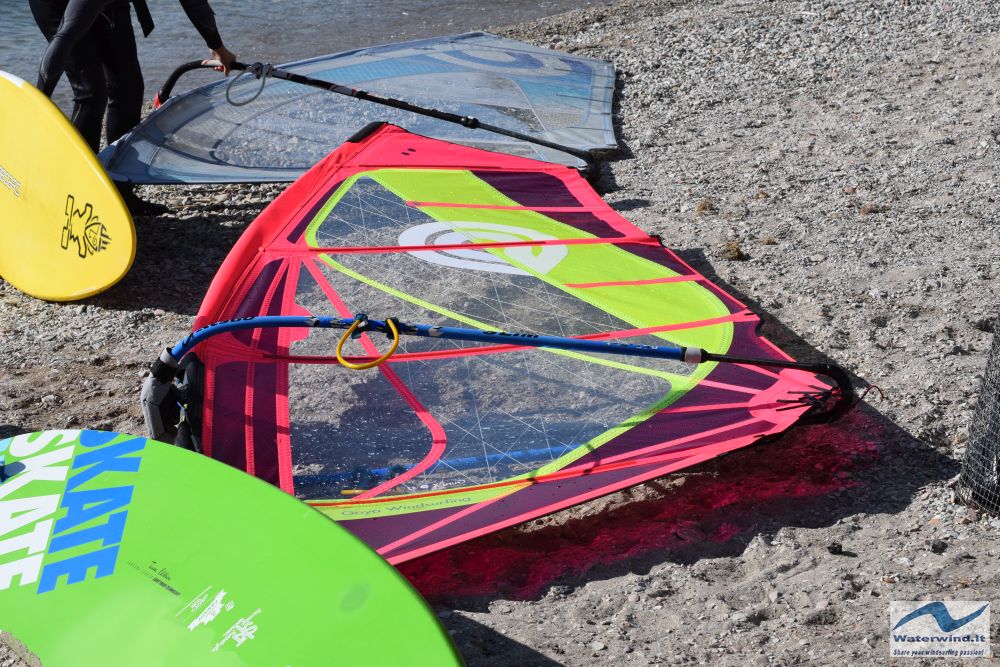
The excellent impressions were also confirmed by our session held in Imperia's Golden Beach, in November 2019 (read report), in ideal conditions for waveriding: side/side-on wind, at about 25 knots, with 2-2.5 meters waves. Finding a slight initial overpowering, offshore, in the first part of the session, I rigged the sail by fixing the boom end to the lower clew ring. With this trimming, the sail was adequately powerful on the shore, to overcome the breakers, but, at the same time, madly neutral and stable offshore, where the wind was much stronger, especially when you were on a wave lip. The Guru has held up the momentary overpowering very well, even if, of course, beyond a certain limit, it is necessary to go down in size.
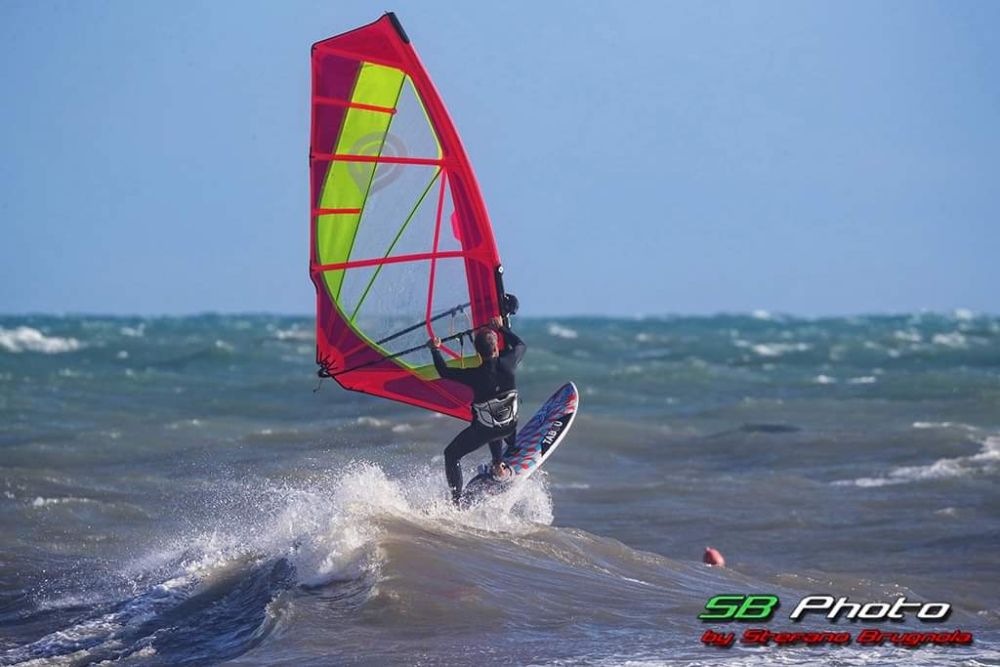
In short, even if waiting for some further testing sessions (perhaps, in France and or Sardinia wave spots, and waiting to take the sail with me to South Africa), I can already say that the Goya Guru Pro 2020/21 is a very versatile sail, that will immediately impress those who try it for the first time. It is perfect for modern waveriding (with mixed wave and freestyle maneuvers), in spots that offer good conditions with side/side off wind, but which also makes its excellent service even in bump and jump conditions, making the ride very pleasant and relaxing.
In wave spots, with light and/or onshore wind, and big waves, or if the rider is heavy, it may be preferable to opt for the Goya Banzai (read test). If we have additional clues to report, we will update the article.
Aloha. Fabio Muriano
Without your Support, Waterwind wouldn't exist. Become our supporter!
If you want to advertise with us, read here, or contact us.
Collaborate with us. Read here!
Buy our Gadgets! Visit our YouTube channel!





